AN OVERVIEW OF MODAL-BASED DAMAGE
IDENTIFICATION METHODS
Charles R. Farrar and Scott W. Doebling
Engineering Analysis Group
Los Alamos National Laboratory
Los Alamos, NM
ABSTRACT
this
is
technology
This paper provides an overview of methods that examine changes
in measured vibration response to detect, locate, and characterize
damage in structural and mechanical systems. The basic idea
behind
that modal parameters (notably
frequencies, mode shapes, and modal damping) are functions of
the physical properties of the structure (mass, damping, and
stiffness). Therefore, changes in the physical properties will cause
detectable changes in the modal properties. The motivation for the
development of this technology is first provided. The methods are
then categorized according to various criteria such as the level of
damage detection provided, model-based vs. non-model-based
methods and linear vs. nonlinear methods. This overview is
limited to methods that can be adapted to a wide range of
structures (i.e., are not dependent on a particular assumed model
form for the system such as beam-bending behavior and methods
and that are not based on updating finite element models). Next,
the methods are described in general terms including difficulties
associated with their implementation and their fidelity. Past,
current and future-planned applications of this technology to
�
actual engineering systems are summarized. The paper concludes
with a discussion of critical issues for future research in the area of
modal-based damage identification.
INTRODUCTION
The interest in the ability to monitor a structure and detect damage
at the earliest possible stage is pervasive throughout the civil,
mechanical and aerospace engineering communities. Current
damage-detection methods are either visual or
localized
experimental methods such as acoustic or ultrasonic methods,
magnetic field methods, radiograph, eddy-current methods and
thermal field methods (Doherty [1]). All of these experimental
techniques require that the vicinity of the damage is known a
priori and that the portion of the structure being inspected is
readily accessible. Subjected
these
experimental methods can detect damage on or near the surface of
the structure. The need for additional global damage detection
methods that can be applied to complex structures has led to the
development and continued research of methods that examine
changes in the vibration characteristics of the structure.
limitations,
to
these
The increase in research activity regarding vibration-based damage
detection is the result of the coupling between many factors that
can be generally categorized as spectacular failures resulting in
loss of life that have received ample news media coverage,
economic concerns, and recent technical advancements. Failures
such as the in-flight loss of the exterior skin on an Aloha Airlines
flight in Hawaii and the resulting media coverage focus the
public’s attention on the need for testing, monitoring, and
evaluation to ensure the safety of structures and mechanical
systems used by the public. The publics’ concerns, in turn,
focuses politicians attention on this issue and, hence, industry and
regulatory agencies are
the funding
resources necessary for the development and advancement of this
technology. The current state of our infrastructure and the
economics associated with its repair have also been motivating
factors for the development of methods that can be used to detect
the onset of damage or deterioration at the earliest possible stage.
to provide
influenced
�
Finally, increases in cost-effective computing memory and speed,
advances in sensors including non-contact and remotely monitored
sensors, adaptation and advancements of the finite element
method, adaptation of modal testing (most recently by the civil
engineering community), and development of nonlinear system
identification methods all represent technical advancements that
have contributed
in modal-based damage
detection.
to advancements
It is the authors’ speculation that damage or fault detection, as
determined by changes in the dynamic properties or response of
systems has been practiced in a qualitative manner, using acoustic
techniques, since modern man has used tools. More recently, this
subject has received considerable attention in the technical
literature where there have been a concerted effort to develop a
firmer mathematical and physical foundation for this technology.
However, the basic idea remains that commonly measured modal
parameters (notably frequencies, mode shapes, and modal
damping) are functions of the physical properties of the structure
(mass, damping, and stiffness). Therefore, changes in the physical
properties, such as reductions in stiffness resulting from the onset
of cracks or loosening of a connection, will cause detectable
changes in these modal properties. Because changes in modal
properties or properties derived from these quantities are being
used as indicators of damage, the process of modal-based
damage detection eventually reduces to some form of a pattern
recognition problem.
The idea that changes in vibration characteristics can provide
information regarding damage in a structure is very intuitive and
one may ask the question: Why has this technology taken such a
long time to be formally and generally adopted by the modern
engineering community? The answer is that there are several
confounding factors making modal-based damage identification
difficult to implement in practice. First, standard modal
properties represent a form of data compression. Modal
properties are estimated experimentally from measured response-
�
identification procedures commonly referred
time histories. A typical time-history may have 1024 data points,
and if measurements are made at 100 points, there are 102,400
pieces of information regarding the current state of the structure.
For this discussion the additional data typically obtained from
averaging will not be considered as providing supplemental data,
but rather improving the accuracy of 100 measurements. Through
system
to as
experimental modal analysis (Ewins [2]) this volume of data is
reduced to some number of resonant frequencies, mode shapes and
modal damping values. This data compression is done because the
modal quantities are easier to visualize, physically interpret, and
interpret in terms of standard mathematical modeling of vibrating
systems than are the actual time-history measurements. If twenty
real modes are identified, then the 102,400 pieces of information
will have been reduced to 2020-2040 pieces of information (20
modes made up of 100 amplitudes values (99 if one measurement
is used to record the input), 20 resonant frequencies and 20 modal
damping values).
Intuitively, information about the current state of the structure
must be lost in this data reduction and system identification
process. The loss of information occurs primarily from the fact that
for a linear system the modal properties are independent of the
excitation signal characteristics (amplitude and frequency content)
and the location of the excitation whereas the time histories are
not. In addition, if the input excites response at frequencies
greater than those that can be resolved with the specified data
sampling parameters, the identified modes will not provide any
information
response
characteristics of the structure that are contributing to the
measured time-history responses. Within the measured frequency
range of response it is often difficult to identify all the modes
contributing to the measured response because of coupling
between the modes that are closely spaced in frequency. This
difficulty is observed more commonly at the higher frequency
portions of the spectrum where the modal density is typically
greater. Also, the introduction of bias (or systematic) errors, such
as those that arise from windowing of the data and those that arise
frequency
higher
regarding
the
�
from changing environmental conditions during the test, will tend
to make the identified modal parameters less representative of the
true dynamic properties of the structure.
Damage typically is a local phenomenon. Local response is
captured by higher frequency modes whereas lower frequency
modes tend to capture the global response of the structure and are
less sensitive to local changes in a structure. From a testing
standpoint it is more difficult to excite the higher frequency
response of a structure as more energy is required to produce
measurable response at these higher frequencies than at the lower
frequencies. These factors coupled with the loss of information
resulting
time-history
measurements to modal properties add difficulties to the process of
modal-based damage identification and contribute to the current
state where this technology is still in the research arena with only
limited standard practice by the engineering community.
the necessary
from
reduction of
A logical question then is: Why not examine the time-histories
directly for indications of damage? The answer is that, despite the
difficulties associated with damage detection based on changes in
modal properties, it is even more difficult to examine response-
time histories directly, identify that damage has occurred based on
the changes in patterns of these time histories, and relate these
changes to physical changes in the structure. If excitation sources
change and/or environmental conditions change this process
becomes even more difficult. However, it should be pointed out
that when the system response changes from linear to nonlinear
and the location of the damage is known a priori (as is the case
with loosening of bearings on rotating machinery), time histories
alone (actually their frequency domain power spectrum) are
sufficient to identify damage and represent one of the most widely
practiced forms of vibration-based damage identification (Wowk
[3]).
Notwithstanding the difficulties discussed above, advances in
modal-based damage detection over the last 20-30 years have
produced new methods of examining vibration data for indications
�
of structural damage. These methods are seeing more widespread
applications. One of the most prominent examples of this recent
application is NASA’s space shuttle modal inspection system
(Hunt, et al. [4]). Because of difficulties accessing the exterior
surface caused by the thermal protective system, a modal-based
damage detection system was developed. This system has
identified damage that would have alluded traditional NDT
methods because of inaccessibility to the damaged components
and has been adopted as a standard inspection tool for the shuttles.
literature (Doebling, et al. [5]).
It is the intent of this paper to provide an overview of these recent
advances in modal-based damage detection. This paper is based
on a previous detailed review of the modal-based damage
detection
As mentioned
previously, the field of damage identification is very broad and
encompasses both local and global methods. This paper will be
limited to global methods that are used to infer damage from
changes in vibration characteristics of the structure. Many
different issues are critical to the success of using the mechanical
vibration characteristics of a structure for damage identification
and health monitoring. Among the important issues are excitation
and measurement considerations, including the selection of the
type and location of sensors, and the type and location of the
excitations. Another important topic is signal processing, which
includes such methods as Fourier analysis, time-frequency analysis
and wavelet analysis. In this paper, these peripheral issues will not
be directly addressed. The scope of this paper will be limited to the
methods that use changes in modal properties (i.e. modal
frequencies, modal damping ratios, and mode shapes) to infer
changes in mechanical properties, and the application of these
methods to engineering problems. Methods that require a finite
element model of the structure are not included in this discussion.
CLASSIFICATION OF DAMAGE AND DAMAGE ID
METHODS
�
The effects of damage on a structure can be classified as linear or
nonlinear. A linear damage situation is defined as the case when
the initially linear-elastic structure remains linear-elastic after
damage. The changes in modal properties are a result of changes in
the geometry and/or the material properties of the structure, but the
structural response can still be modeled using linear equations of
motion. Linear methods can be further classified as model-based
and non-model-based. Model-based methods assume that the
monitored structure responds in some predetermined manner such
as the response described by Euler-Bernoulli beam theory.
Nonlinear damage is defined as the case when the initially linear-
elastic structure behaves in a nonlinear manner after the damage
has been introduced. One example of nonlinear damage is the
formation of a fatigue crack that subsequently opens and closes
under the normal operating vibration environment. Other examples
include loose connections that rattle and nonlinear material
behavior such as that exhibited by foam rubber. The majority of
the studies reported in the technical literature address only the
problem of linear damage detection.
Another classification system for damage-identification methods,
defines four levels of damage identification, as follows (Rytter
[6]):
• Level 1: Determination that damage is present in the
structure
• Level 2: Level 1 plus determination of the geometric
location of the damage
• Level 3: Level 2 plus quantification of the severity of the
damage
• Level 4: Level 3 plus prediction of the remaining service
life of the structure
To date, modal-based damage identification methods that do not
make use of some structural model primarily provide Level 1 and
Level 2 damage identification. When modal-based methods are
coupled with a structural model, Level 3 damage detection can be
�
obtained in some cases. Level 4 prediction is generally associated
with the fields of fracture mechanics, fatigue life analysis, or
structural design assessment and, as such, is not addressed in this
paper.
EARLY DIFFICULTIES
Most of the modern developments in modal based damage
detection stem from studies performed in the 1970s and early
1980s by the offshore oil industry (Vandiver [7,8], Begg [9],
Loland and Dodds [10], Wojnarowski [11], Coppolino and Rubin
[12], Duggan et al. [13], Kenley and Dodds [14], Crohas and
Lepert [15], Nataraja [16], and Whittome and Dodds [17]).
However, these studies were less than successful. Instead, it was
found
that above-water-line measurements could provide
information about resonant frequencies only. Environmental
conditions such as marine growth that adds significant mass to the
structure, equipment noise and changing mass associated with
changing fluid tank levels corrupted the data. These tests also
identified uniqueness issues associated with the damage prediction
if only resonant frequencies are used. Because of the lack of
success, the oil industry abandoned this technology in the mid
1980s.
DAMAGE DETECTION BASED ON CHANGES IN BASIC
MODAL PROPERTIES
The experiences of the offshore oil industry have been repeated by
numerous other investigators who have tried to examine changes
in basic modal properties. In this context basic modal properties
will be defined as resonant frequencies, modal damping, and mode
shape vectors.
Frequency Changes
The amount of literature related to damage detection using shifts
in resonant frequencies is quite large. The observation that
changes in structural properties cause changes in vibration
frequencies was the impetus for using modal methods for damage
�
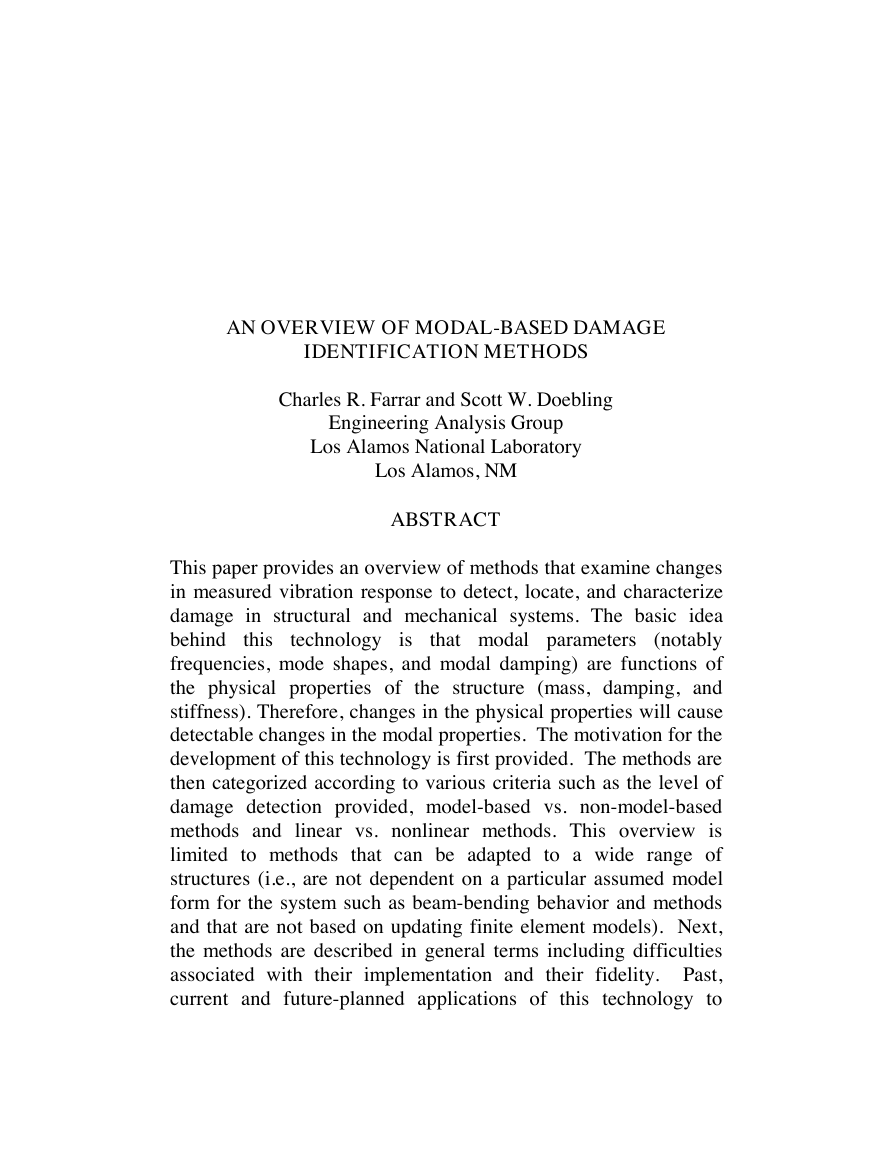
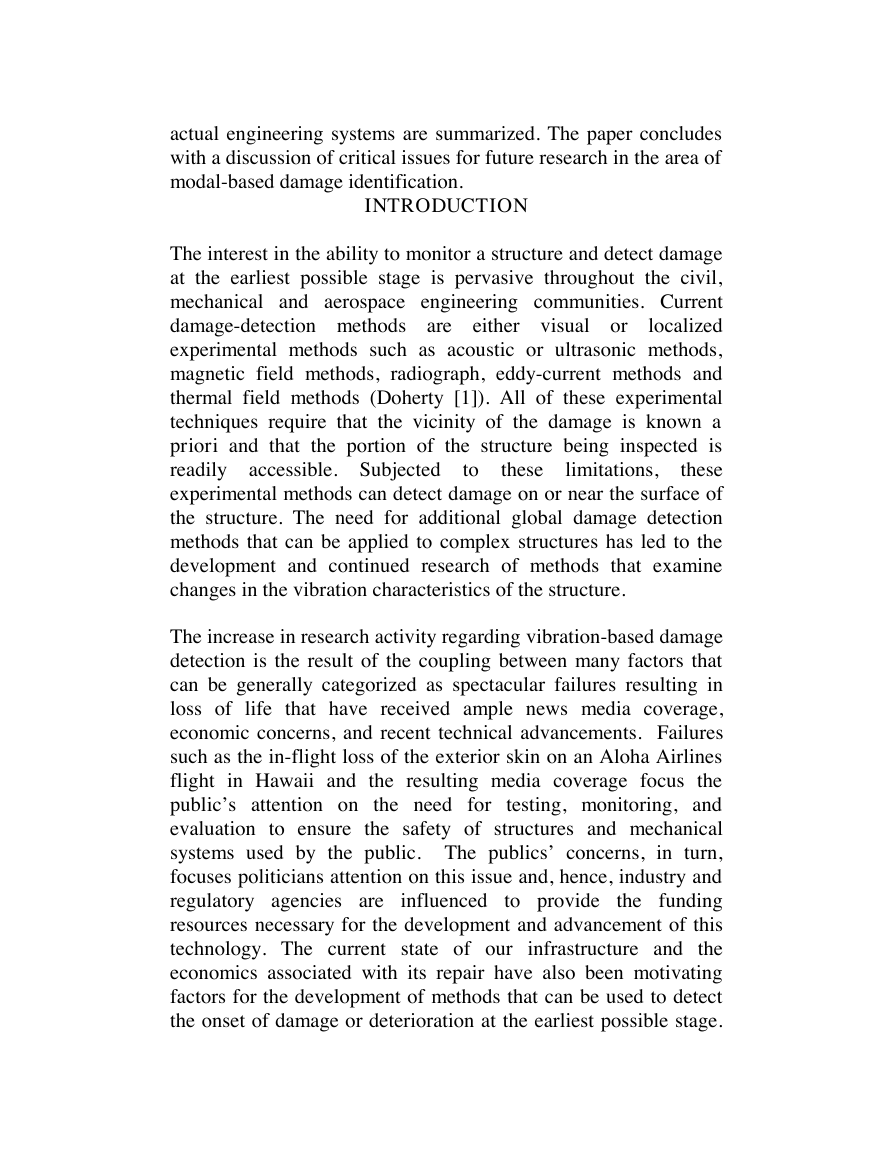
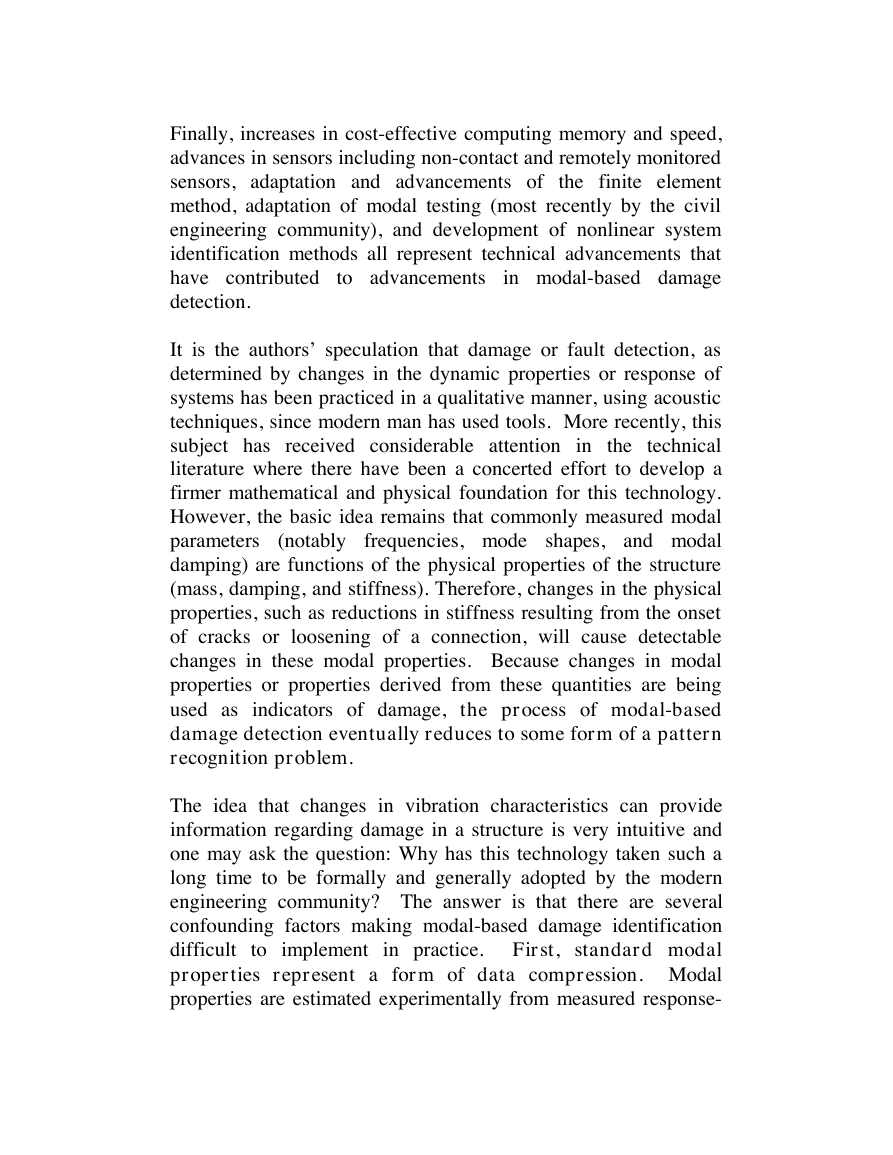
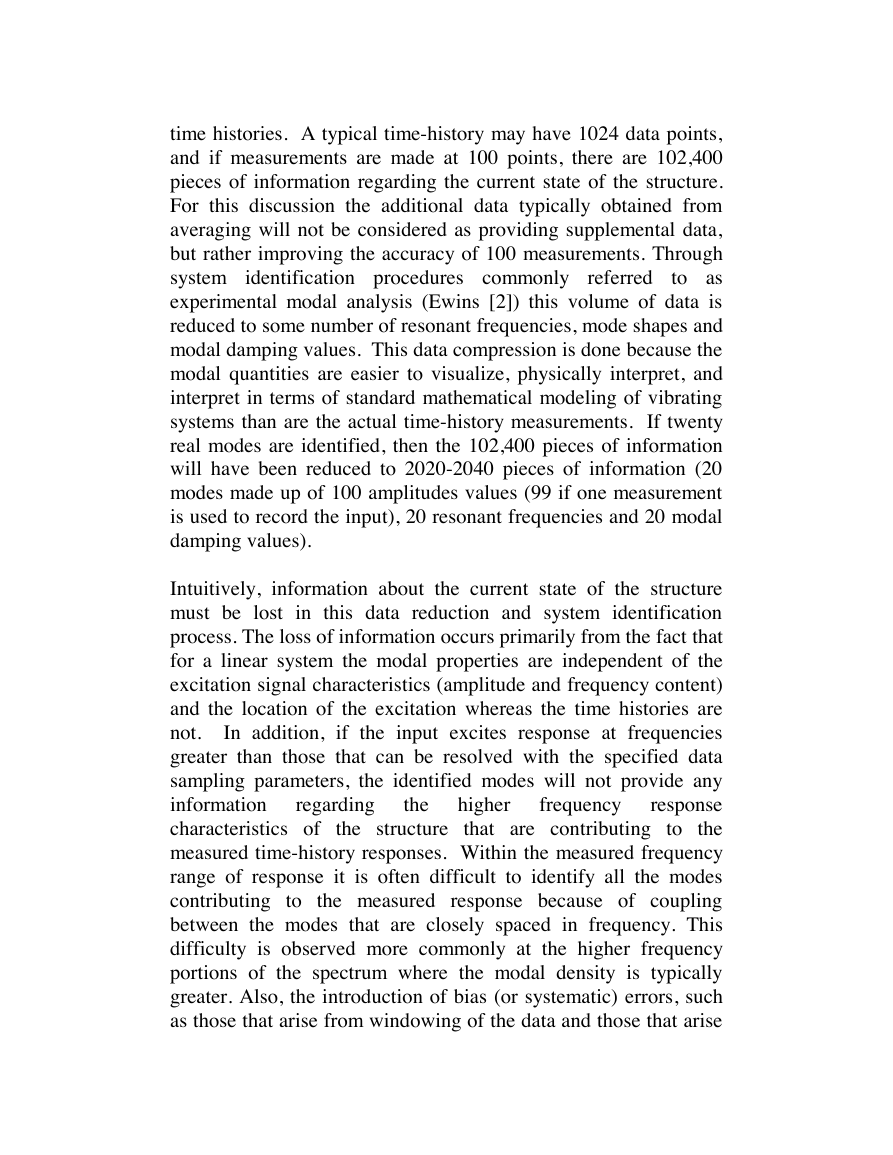
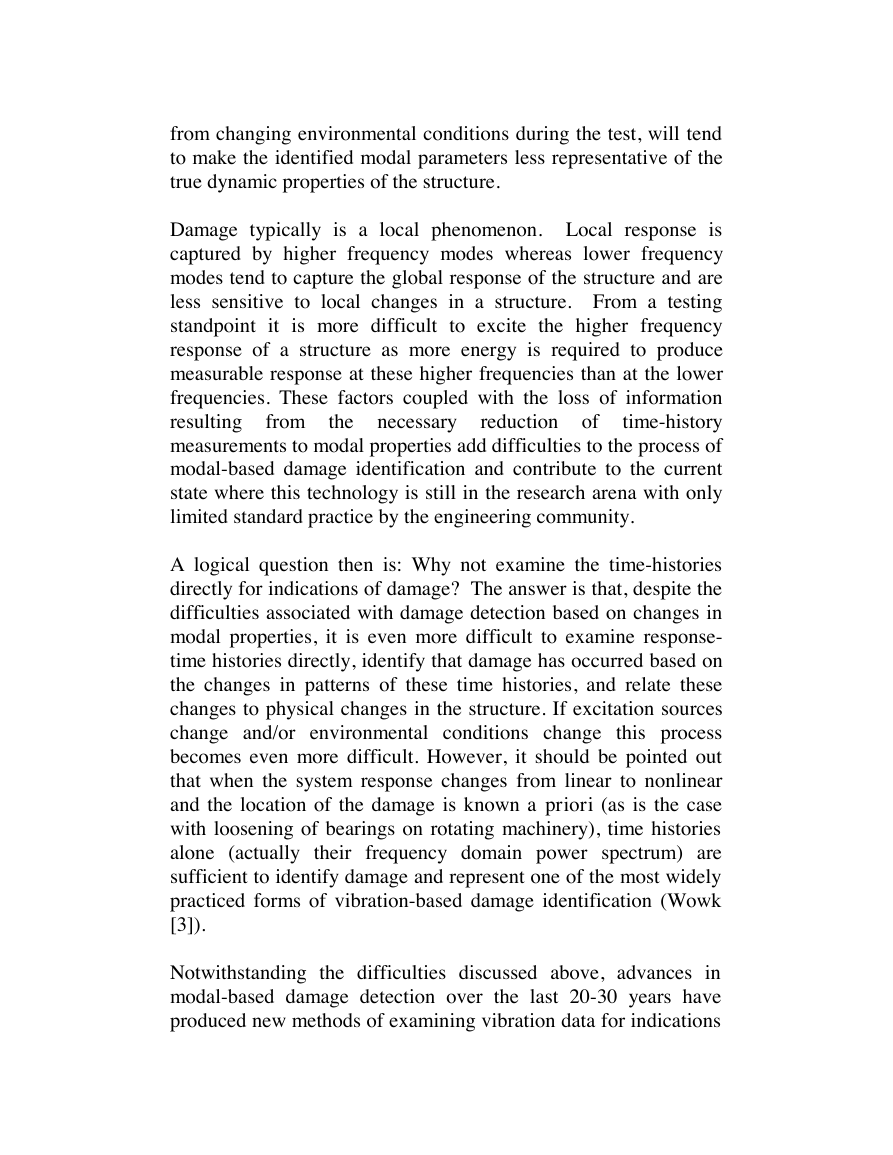
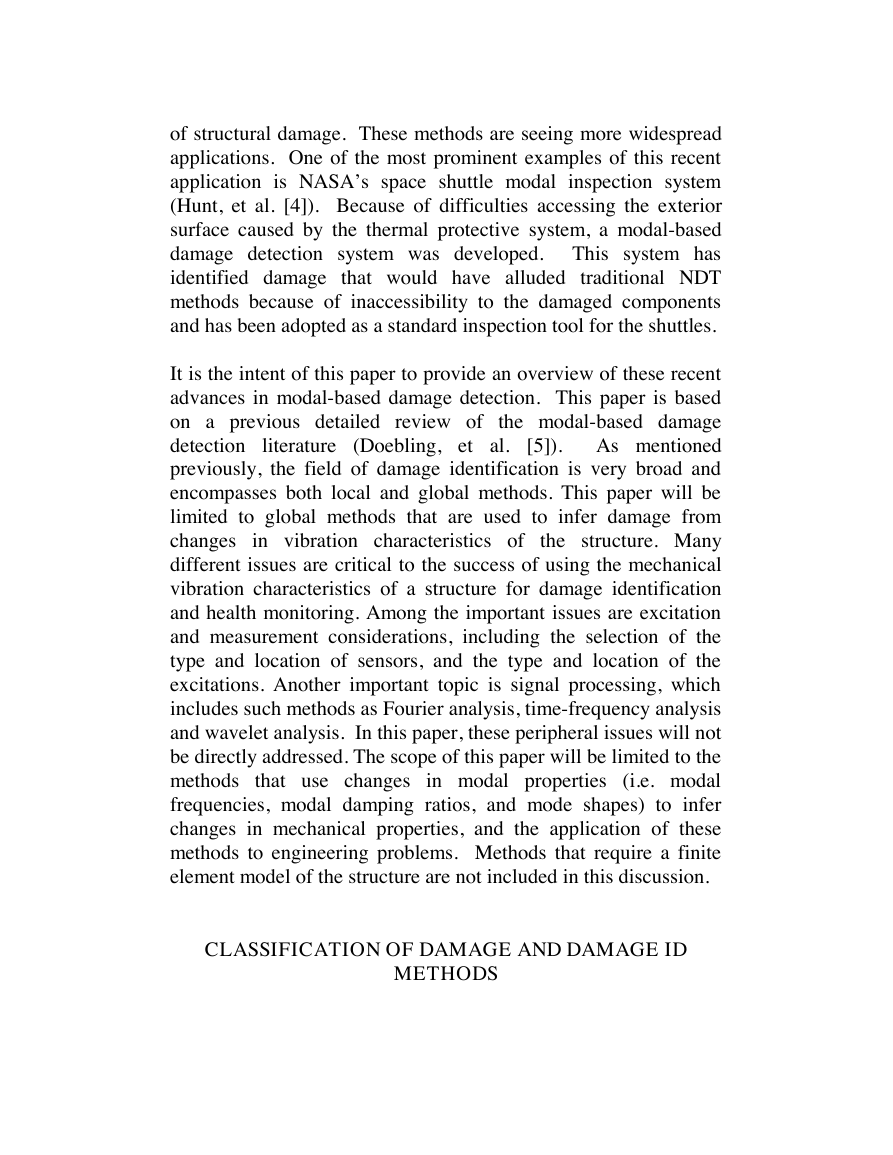
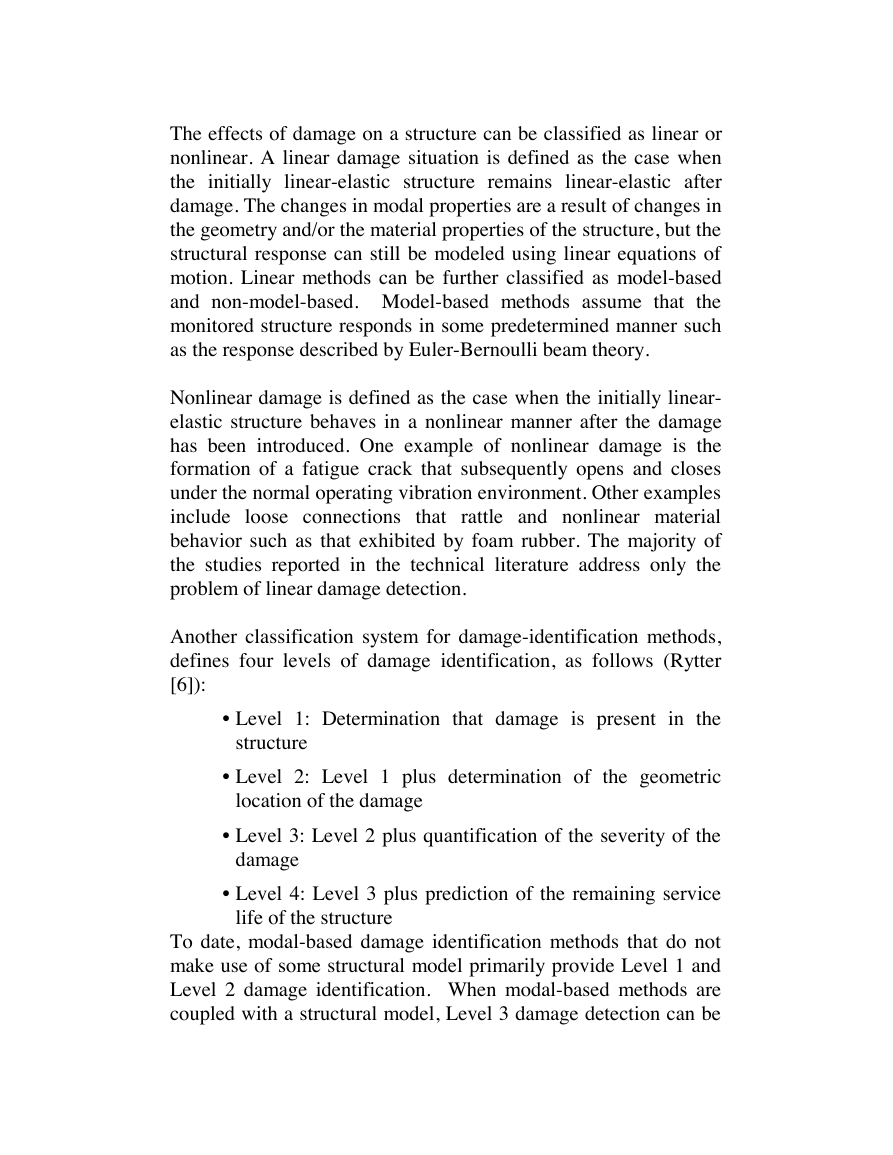
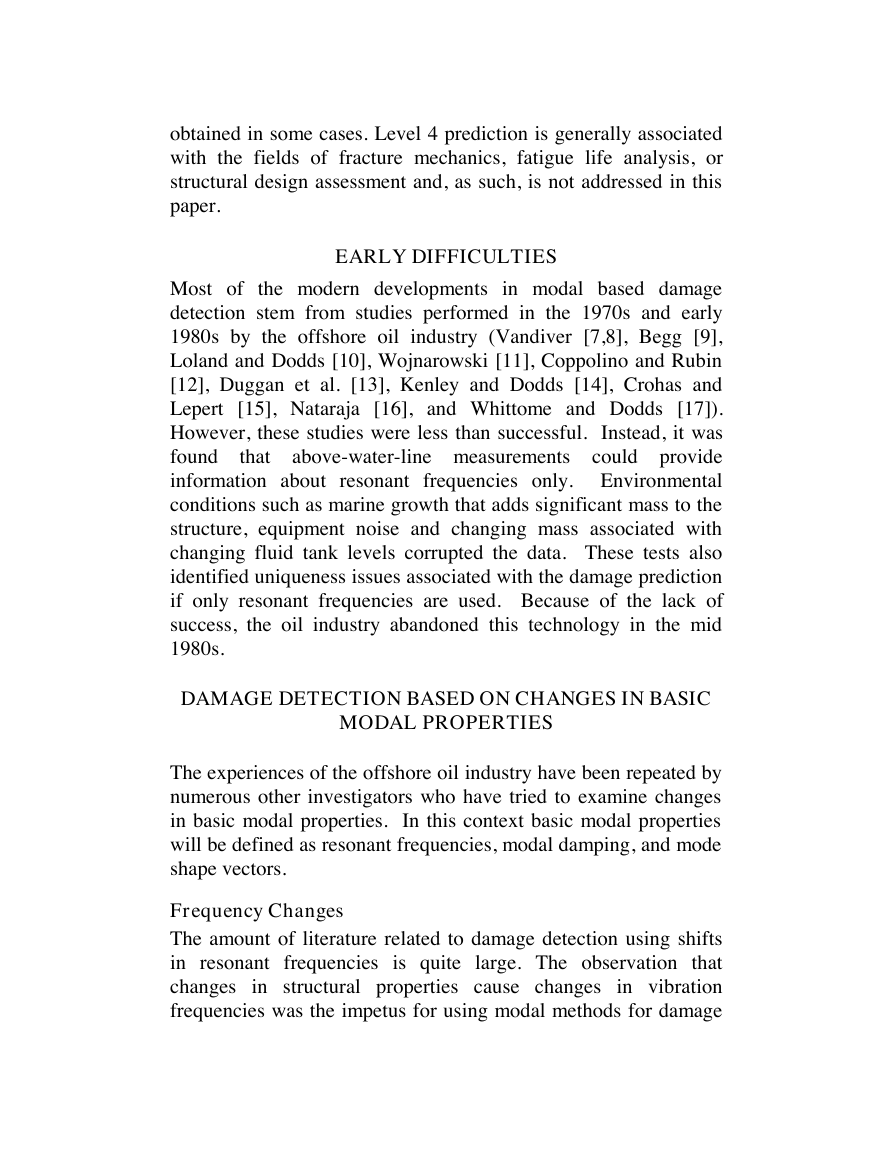








 2023年江西萍乡中考道德与法治真题及答案.doc
2023年江西萍乡中考道德与法治真题及答案.doc 2012年重庆南川中考生物真题及答案.doc
2012年重庆南川中考生物真题及答案.doc 2013年江西师范大学地理学综合及文艺理论基础考研真题.doc
2013年江西师范大学地理学综合及文艺理论基础考研真题.doc 2020年四川甘孜小升初语文真题及答案I卷.doc
2020年四川甘孜小升初语文真题及答案I卷.doc 2020年注册岩土工程师专业基础考试真题及答案.doc
2020年注册岩土工程师专业基础考试真题及答案.doc 2023-2024学年福建省厦门市九年级上学期数学月考试题及答案.doc
2023-2024学年福建省厦门市九年级上学期数学月考试题及答案.doc 2021-2022学年辽宁省沈阳市大东区九年级上学期语文期末试题及答案.doc
2021-2022学年辽宁省沈阳市大东区九年级上学期语文期末试题及答案.doc 2022-2023学年北京东城区初三第一学期物理期末试卷及答案.doc
2022-2023学年北京东城区初三第一学期物理期末试卷及答案.doc 2018上半年江西教师资格初中地理学科知识与教学能力真题及答案.doc
2018上半年江西教师资格初中地理学科知识与教学能力真题及答案.doc 2012年河北国家公务员申论考试真题及答案-省级.doc
2012年河北国家公务员申论考试真题及答案-省级.doc 2020-2021学年江苏省扬州市江都区邵樊片九年级上学期数学第一次质量检测试题及答案.doc
2020-2021学年江苏省扬州市江都区邵樊片九年级上学期数学第一次质量检测试题及答案.doc 2022下半年黑龙江教师资格证中学综合素质真题及答案.doc
2022下半年黑龙江教师资格证中学综合素质真题及答案.doc